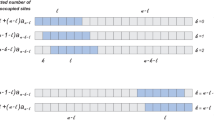Abstract
The number of substrate molecules that can bind to the active site of an enzyme at one time is constrained. This paper develops boundary conditions that correspond to the constraint of single-occupancy binding. Two simple models of substrate molecules diffusing to a single-occupancy site are considered. In the interval model, a fixed number of substrate molecules diffuse in a bounded domain. In the spherical model, a varying number of molecules diffuse in a domain with boundary conditions that model contact with a reservoir containing a large number of substrate molecules. When the diffusive time scale is much shorter than the time scale for entering the single-occupancy site, the dynamics of binding are accurately described by simple approximations.
Similar content being viewed by others
References
Agmon, N., Hopfield, J.J., 1983. Transient kinetics of chemical reactions with bounded diffusion perpendicular to the reaction coordinate: intramolecular processes with slow conformational changes. J. Chem. Phys. 78(11), 6947–6959.
Bernèche, S., Roux, B., 2003. A microscopic view of conduction through the Streptomyces lividans K + channel. Proc. Natl. Acad. Sci. USA 100, 8644–8648.
Doering, C.R., 2000. Effect of boundary condition fluctuations on Smoluchowski reaction rates. In: Freund, J.A., Pöstel, T. (Eds.), Stochastic Processes in Physics Chemistry and Biology, pp. 316–326. Springer, Berlin.
Elston, T.C., Doering, C.R., 1996. Numerical and analytical studies of nonequilibrium fluctuation-induced transport processes. J. Stat. Phys. 83, 359–383.
Gardiner, C.W., 1983. Handbook of Stochastic Methods. Springer, Berlin.
Gillespie, D.T., 1977. Exact stochastic simulations of coupled chemical reactions. J. Phys. Chem. 81, 2340–2361.
Im, W., Seefeld, S., Roux, B., 2000. A Grand Canonical Monte Carlo Brownian dynamics algorithm for simulating ion channels. Biophys. J. 79, 788–801.
Kirchhoff, H., Horstmann, S., Weis, E., 2000. Control of photosynthetic electron transport by PQ diffusion microdomains in thylakoids of higher plants. Biochim. Biophys. Acta 1459, 148–168.
Kramers, H.A., 1940. Brownian motion in a field of force. Physica 7, 284–304.
Levitt, D.G., 1986. Interpretation of biological ion channel flux data: reaction rate versus continuum theory. Annu. Rev. Biophys. Biophys. Chem. 15, 29–57.
Liggett, T.M., 1985. Interacting Particle Systems. Springer, New York.
Lin, J.-C., Doering, C.R., ben-Avraham, D., 1990. Joint density closure schemes for a diffusion-limited reaction. Chem. Phys. 146, 355–371.
McGill, P., Schumaker, M.F., 1996. Boundary conditions for single-ion diffusion. Biophys. J. 71, 1723–1742.
Nadler, B., Naeh, T., Schuss, Z., 2001. The stationary arrival process of independent diffusers from a continuum to an absorbing boundary is Poissonian. SIAM J. Appl. Math. 62(2), 433–447.
Nadler, B., Naeh, T., Schuss, Z., 2003. Connecting a discrete ionic simulation to a continuum. SIAM J. Appl. Math. 63(3), 850–873.
Omoto, C.K., Johnson, K.A., 1986. Activation of the dynein adenosinetriphosphatase by microtubules. Biochemisty 25, 419–427.
Perko, L., 2001. Differential Equations and Dynamical Systems, 3rd edn., p. 245. Springer, Berlin.
Risken, H., 1989. The Fokker–Planck Equation. Springer, Berlin.
Schumaker, M.F., 2002. Boundary conditions and trajectories of diffusion processes. J. Chem. Phys. 116(6), 2469–2473.
Schumaker, M.F., Kentler, C.J., 1996. Far field analysis of coupled bulk and boundary layer diffusion toward an ion channel entrance. Biophys. J. 74, 2235–2248.
Schumaker, M.F., Watkins, D.S., 2004. A framework model based on the Smoluchowski equation in two reaction coordinates. J. Chem. Phys. 121, 6134–6144.
Song, Y., Zhang, Y., Shen, T., Bajaj, C.G., McCammon, J.A., Baker, N.A., 2004. Finite element solution of the steady-state Smoluchowski equation for rate constant calculations. Biophys. J. 86, 2017–2029.
Wang, H., Peskin, C.S., Elston, T.C., 2003. A robust numerical algorithm for studying biomolecular transport processes. J. Theor. Biol. 221, 491–511.
Xing, J., Wang, H., Oster, G., 2005. From continuum Fokker–Planck models to discrete kinetic models. Biophys. J. 89, 1551–1563.
Author information
Authors and Affiliations
Corresponding author
Rights and permissions
About this article
Cite this article
Schumaker, M.F. Single-Occupancy Binding in Simple Bounded and Unbounded Systems. Bull. Math. Biol. 69, 1979–2003 (2007). https://doi.org/10.1007/s11538-007-9201-5
Received:
Accepted:
Published:
Issue Date:
DOI: https://doi.org/10.1007/s11538-007-9201-5



